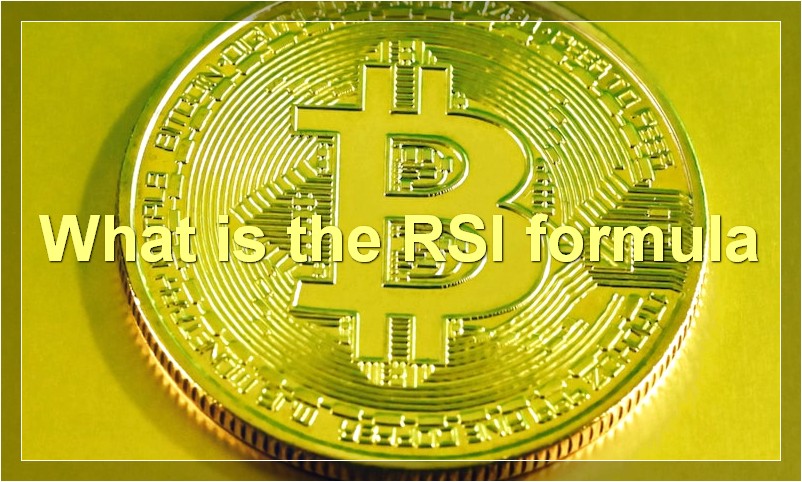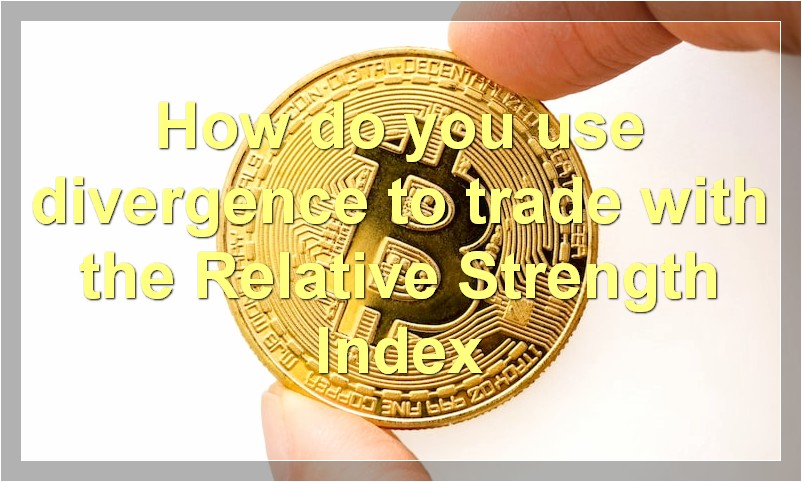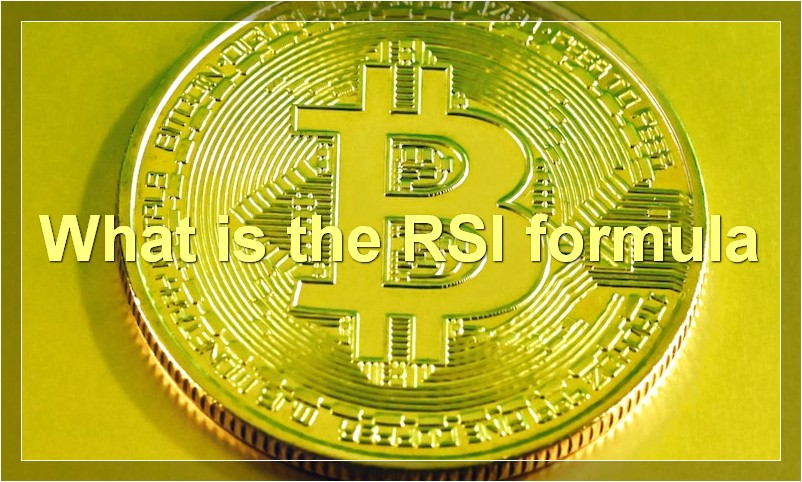If you’re looking to get started in the world of technical analysis, the Relative Strength Index is a great place to start. In this article, we’ll break down everything you need to know about the RSI, including how it’s calculated and how you can use it to make better trading decisions.
How is the Relative Strength Index (RSI) calculated
The Relative Strength Index (RSI) is a momentum indicator that measures the magnitude of recent price changes to evaluate overbought or oversold conditions in the price of a security. The RSI is displayed as an oscillator and moves between zero and 100. Read on to learn how the RSI is calculated and how you can use it to make better informed trading decisions.
The RSI is calculated using the following formula:
RSI = 100 – (100 / (1 + RS))
where RS = Average Gain / Average Loss
First, we need to calculate the average gain and average loss over the specified period. For this example, let’s use a 14-day period.
We begin by calculating the first part of the formula, RS. To do this, we take the average gain over the last 14 days and divide it by the average loss over the same period.
RS = (Average Gain / Average Loss)
= (($12 – $10 + $8 – $6 + $5 – $2 + $4) / 7) / (($10 – $12 + $6 – $8 + $2 – $5 + $4) / 7)
= 1.143
Next, we plug this value into the RSI formula to calculate the index:
RSI = 100 – (100 / (1 + RS))
= 100 – (100 / (1 + 1.143))
= 100 – 87.67
= 12.33
What is the RSI formula

The RSI formula is a technical indicator that measures the magnitude of recent price changes to evaluate overbought or oversold conditions in the market. It is calculated using the following formula:
RSI = 100 – 100/(1 + RS)
Where RS = Average Gain / Average Loss
The RSI ranges from 0 to 100 and is considered overbought when above 70 and oversold when below 30.
How do you interpret the Relative Strength Index
The Relative Strength Index (RSI) is a technical indicator that measures the speed and change of price movements. The RSI is considered a momentum oscillator, meaning it fluctuates between 0 and 100. A reading of 70 or above indicates that an asset is becoming overbought and may be due for a pullback, while a reading below 30 suggests it may be oversold and due for a rebound.
The RSI is calculated using the following formula:
RSI = 100 – 100/(1 + RS)
RS = Average Gain / Average Loss
Average Gain = Sum of Gains over n periods / n
Average Loss = Sum of Losses over n periods / n
n = the number of periods used to calculate the RSI
The most common period used to calculate the RSI is 14, which means that the indicator looks at the past 14 days of price data to generate its readings.
Generally, if the RSI is above 50, this means that the average gains made by the security in question are higher than the average losses. If the RSI is below 50, this means that the average losses are greater than the average gains.
Some traders will also look for divergences between the RSI and price action as potential trading signals. A bullish divergence occurs when the RSI forms higher lows even as price action prints lower lows. This indicates that momentum is shifting in favor of buyers and a reversal may be on the horizon. A bearish divergence occurs when the RSI forms lower highs even as price action prints higher highs. This indicates that momentum is shifting in favor of sellers and a reversal may be on the horizon.
What are overbought and oversold levels
An overbought level is when the price of an asset has risen too high too fast and is likely to fall soon. An oversold level is when the price of an asset has fallen too low too fast and is likely to rise soon.
What is the centerline for the Relative Strength Index
The centerline for the Relative Strength Index (RSI) is 50. The RSI is a technical indicator used to measure the strength of a stock’s recent price performance. The RSI is calculated by taking the average of the stock’s closing prices over a certain period of time and then dividing that number by thestandard deviation of the stock’s closing prices over the same period of time. A stock with a high RSI would have a higher average closing price than a stock with a low RSI.
How do you use divergence to trade with the Relative Strength Index

Divergence is a powerful tool that can be used to trade with the Relative Strength Index (RSI). By looking for divergences between the RSI and the price action, traders can anticipate potential reversals in the market.
Divergence occurs when the RSI moves in a direction opposite of the price action. For example, if the price is making new highs but the RSI is failing to do so, this is bearish divergence. Conversely, if the price is making new lows but the RSI is not, this is bullish divergence.
Divergence can be used as a leading indicator, providing traders with an early warning of potential reversals. It can also be used to confirm other technical signals. For example, if you see a bearish divergence on the RSI and the price is also breaking below support, this could be a strong signal to sell.
When trading with divergence, it’s important to remember that divergences can last for extended periods of time. As such, it’s important to wait for confirmations before entering into a trade. Additionally, always use risk management techniques such as stop-losses to protect your capital.
What are some tips for trading with the Relative Strength Index
There are a few things to keep in mind when trading with the Relative Strength Index. The first is to look for divergences. This is when the price is moving in one direction and the RSI is moving in the opposite direction. This can be a sign that the price is about to move in the opposite direction.
Another thing to keep in mind is overbought and oversold levels. The RSI will often reach overbought or oversold levels before the price does. This can be a good time to take profits or enter into a trade.
Finally, don’t forget to use other indicators in conjunction with the RSI. This will help you confirm any signals that you may see. By using multiple indicators, you can increase your chances of success when trading with the Relative Strength Index.
How do you combine other technical indicators with the Relative Strength Index
When it comes to technical analysis, there are a lot of different indicators that can be used in order to try and predict future price movements. However, one indicator that is often used by traders is the Relative Strength Index (RSI). The RSI is a momentum indicator that measures how strong a recent price move has been.
One way that traders will often use the RSI is by combining it with other technical indicators. For example, if the RSI is showing that a stock is overbought, but the price is still rising, then traders might look at other indicators to see if there are any signs that the price might start to fall soon. This can help them to make more informed decisions about when to enter and exit trades.
It is important to remember that no indicator is perfect, and that they should always be used in conjunction with other forms of analysis. By using multiple indicators, traders can get a better idea of what might happen next in the market, and this can help them to make more profitable trades.
What are some common mistakes traders make when using the Relative Strength Index
There are a few common mistakes that traders make when using the Relative Strength Index (RSI). First, they may enter into a trade too early before the RSI has had a chance to confirm the trend. Second, they may stay in a trade too long after the RSI has signaled a reversal. Third, they may use the RSI as a standalone indicator, rather than incorporating it into a broader trading strategy.
One mistake that many traders make is entering into a trade before the RSI has had a chance to confirm the trend. The RSI is a lagging indicator, which means that it can take some time for it to catch up to price. If you enter into a trade before the RSI has had a chance to confirm the trend, you could end up getting stopped out or taking a loss.
Another mistake that traders make is staying in a trade after the RSI has signaled a reversal. The RSI can give false signals, so it’s important to wait for confirmation from other indicators before exiting a trade. If you stay in a trade after the RSI has signaled a reversal, you could end up giving back all of your profits or even taking a loss.
Finally, some traders use the RSI as a standalone indicator, rather than incorporating it into a broader trading strategy. The RSI should not be used as a standalone indicator because it can give false signals. Instead, it should be used in conjunction with other technical indicators and market analysis to form a complete trading strategy.
Where can I find more information on the Relative Strength Index
The Relative Strength Index (RSI) is a momentum indicator that measures the magnitude of recent price changes to evaluate overbought or oversold conditions in the price of a stock or other asset. The RSI is displayed as an oscillator and can be used to help traders identify trend reversals, price consolidations, and potential entry and exit points.

